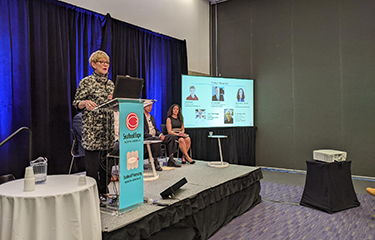Aquaculture innovations will be the key to the seafood industry's future, and the future of feeding humanity, according to a panel of experts from across the seafood industry speaking at the 2022 Seafood Expo North America.
The panel, “Transforming Aquaculture: The Future of Seafood Must Include Innovation," was hosted by AquaBounty CEO Sylvia Wulf and featured representatives from both inside the seafood industry experts in food systems and nutrition.
“We often forget that ... fish, [is] the last hunter-gatherer crop. We don’t go to the wild for our poultry or for cattle,” University of Maryland Department of Marine Biotechnology Chair Yonathan Zohar said. “This obviously has to change [in order to feed a growing global population], and aquaculture must become a more and more-dominant segment of our seafood production.”
Samuels and Son Seafood Vice President of New Product Development Joseph Lasprogata said that for his company, aquaculture has already become an integral part of the business and its importance is only growing.
“I don’t think people realize how big a part aquaculture is to our business as it stands right now,” he said. “We’re a wholesaler in Philadelphia, and over 65 percent of the products that we buy, right now, are coming from aquaculture.”
Lasprogata said that as seafood demand has grown through the COVID-19 pandemic, the ability to purchase wild-caught product is falling.
“There’s less and less availability of products,” he said. “So the future of seafood is in aquaculture. That’s already been decided, that’s not really a question. But how we’re going to do it, that’s the question.”
One of the first solutions that the panel brought up was recirculating aquaculture systems (RAS), a type of system that Zohar said brings aquaculture closer to more traditional farming methods.
“Much of the intensive aquaculture industry is now carried out in floating net-pens in coastal environments, which has not always been very friendly to the environment, although it’s becoming better,” he said.
The issues with that, he said, is there’s limited coastal space that is appropriate for farming certain species of fish, and newer offshore technologies are still in early stages – two facts which have helped lead to a huge rise in investment in RAS.
“I think right now there is conservatively around USD 3 billion [EUR 2.6 billion], either active investment or in the pipeline, in land-based production of Atlantic salmon,” Zohar said.
On the selling side, Lasprogata said that RAS would provide logistical and environmental advantages.
“Supply chain is so important. With the availability of the RAS system to raise products – and it’s a wide variety of species and it expands every day – in a local environment where I don’t have to fly it, depend on airlines, depend on thousands of miles of transportation – that’s an advantage to us,” Lasprogata said.
Sage Leaf Communications President Elena Natker said another innovation coming to the seafood industry is in aquafeed.
“The aquaculture model is really important for nutrition and for sustainability because we can control their diet. We know what’s going into the fish, so that when we consume the fish, we know what’s going into us,” she said.
Algae feed and other alternative feed types can be a boon for multiple species, she said. Salmon are typically the first species consumers think of when seeking out omega-3 fatty acids, but it is possible to give species a boost in omega-3 content through advancing feed technology, Natker said.
“If we could get [omega-3s] into, let’s say tilapia, which is [currently] not a good source of omega-3s, that would be wonderful,” Natker said. “Other types of nutrients that you get … vitamin B-12, your trace nutrients like selenium and zinc, seafood is really the only places where you can get those nutrients unless it has been fortified into other foods. Getting it into the diets of our fish, so that then it can be suitable for human consumption, would go a long way into helping people get the nutrition that they need.”
Despite the seafood industry's reputation for being "old school," Lasprogata said its technological uptake has been rapid. He said the industry needs to do a better job of touting those advances.
“I think that’s the one mistake we as an industry make … is we don’t share the technology. There’s so many cool systems out there,” he said. “I think the younger generation really does embrace technology. Be proud of this, and brag about where this product is coming from, and not keep reliving the same misnomers that were created 40 years ago.”
Lasprogata said innovation has ocurred at all levels of the industry.
“The one I find most amazing is the advent of aquaculture oysters and shellfish. I mean that has impacted the industry so completely in the last 10 years. Ten years ago, we would occasionally get a bushel of oysters from the Chesapeake, and there was rocks and barnacles and crabs, [making it a] very hard product to use," Lasprogata said. "I would say next to salmon, shellfish is [now] on every menu on the East Coast, whether it’s mussels, oysters, or clams. And it’s amazing that it’s a high-quality, safe, easy-to-use product.”
Photo by Chris Chase/SeafoodSource







